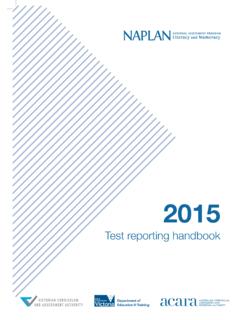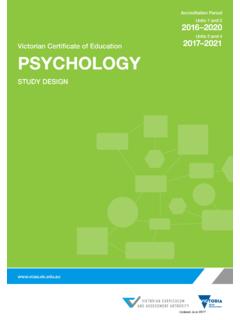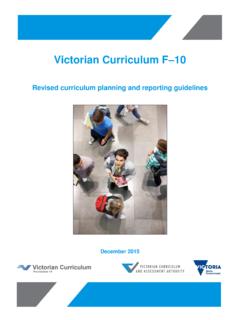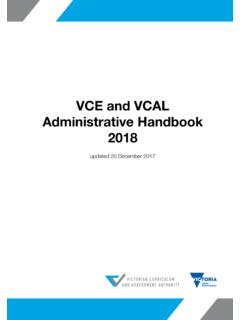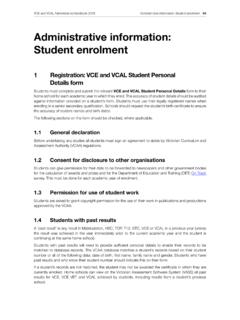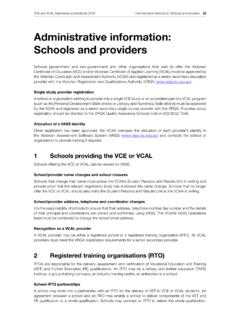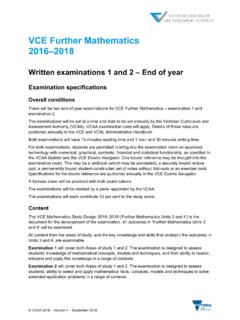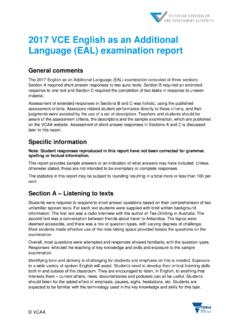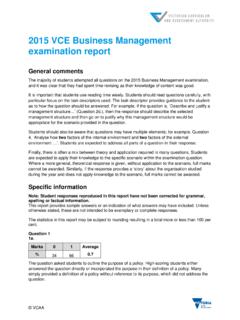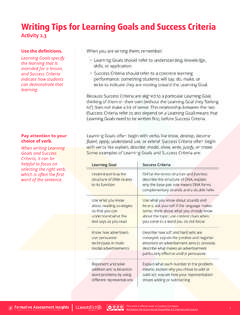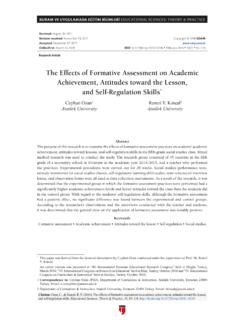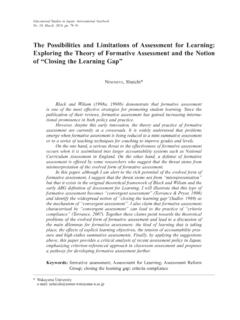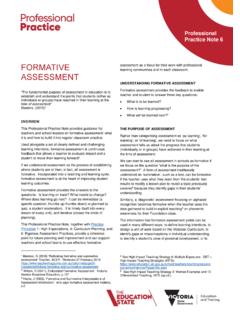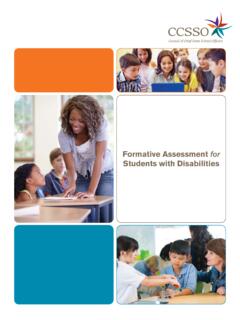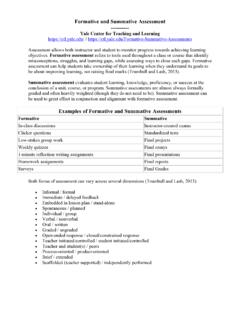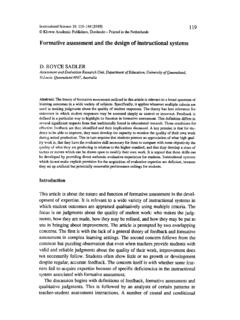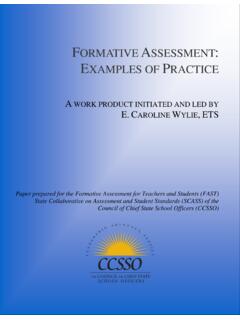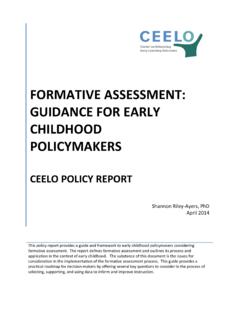Transcription of Guide to Formative Assessment Rubrics - Pages
1 Guide to Formative Assessment Rubrics Victorian Curriculum F 10 The Victorian Curriculum and Assessment Authority acknowledges the contribution of Pam Robertson, Jason Pietzner and Narelle English, Assessment Research Centre, University of Melbourne, in the development of this Guide . Authorised and published by the Victorian Curriculum and Assessment Authority Level 7, 2 Lonsdale Street Melbourne VIC 3000 ISBN: 978-1-925676-95-2 Victorian Curriculum and Assessment Authority 2019. Exposure draft published for trialling and feedback July 2018. No part of this publication may be reproduced except as specified under the Copyright Act 1968 or by permission from the VCAA. Excepting third-party elements, schools may use this resource in accordance with the VCAA educational allowance.
2 For more information go to: The VCAA provides the only official, up-to-date versions of VCAA publications. Details of updates can be found on the VCAA website: This publication may contain copyright material belonging to a third party. Every effort has been made to contact all copyright owners. If you believe that material in this publication is an infringement of your copyright, please email the Copyright Officer: Copyright in materials appearing at any sites linked to this document rests with the copyright owner/s of those materials, subject to the Copyright Act. The VCAA recommends you refer to copyright statements at linked sites before using such materials. The VCAA logo is a registered trademark of the Victorian Curriculum and Assessment Authority.
3 Guide to Formative Assessment Rubrics Contents Introduction .. 1 Student learning and Assessment .. 1 What is Formative Assessment ? .. 2 Purpose of the Guide .. 2 Structure of the Guide .. 3 Part 1: Describing a learning continuum .. 4 What is a learning continuum and why is it needed? .. 4 What is a curriculum continuum? .. 5 Using the Victorian Curriculum F 10 as a learning 6 Using professional expertise to develop a more granular learning continuum .. 7 Part 1 summary .. 10 Part 2: Developing a Formative Assessment rubric .. 11 What makes up the rubric structure and how does this assist in describing increasing sophistication? .. 11 Refining the rubric to support consistent Assessment .. 15 Communicating learning expectations to intended users.
4 15 Part 3: Collecting, interpreting and using evidence to plan for teaching and 17 Collecting evidence of student learning .. 17 Interpreting evidence of student learning .. 17 Using Formative Assessment to plan for teaching and learning .. 18 Part 4: Formative Assessment Rubrics in practice .. 19 Worked example: Literacy .. 19 Worked example: Numeracy .. 21 Next steps for schools .. 23 Glossary .. 24 Further reading .. 25 Appendix: Victorian Curriculum F 10 structure .. 26 Guide to Formative Assessment Rubrics VCAA Page 1 Introduction Student learning and Assessment Student learning is produced, shaped and affected by four connected components. Each component plays a distinct role in the process of student learning and is interconnected with all of the others.
5 The four components of student learning include the what, how, how well and where of student learning : The Victorian Curriculum F 10 is a set of progressions that define increasingly complex knowledge, skills and concepts grouped and defined by learning areas and capabilities. The Victorian Curriculum F 10 is not set out according to nominal school year levels but to developmental levels on a continuum of learning , which allows a teacher to point to current levels of achievement for every student and allows for appropriate planning for expected levels of achievement. Because of this structure, the Victorian Curriculum F 10 facilitates an increased focus in Victorian schools on the development of personalised learning programs for all students, where curriculum delivery is planned in relation to the actual learning level of each student rather than their assumed level of learning .
6 This is consistent with Vygotsky s now widely cited concept of the zone of proximal development . This concept is picked up in the Revised Curriculum Planning and Reporting Guidelines (VCAA 2015) with a quotation from Australian Council for Educational Research Chief Executive Officer Geoff Masters: It is well understood at the level of the classroom that successful learning is more likely when individual learners are given learning opportunities appropriate to their current levels of achievement and learning needs. Guide to Formative Assessment Rubrics VCAA Page 2 What is Formative Assessment ? Formative Assessment is any Assessment that is used to improve teaching and learning . Best-practice Formative Assessment uses a rigorous approach in which each step of the Assessment process is carefully thought through.
7 Assessment is a three-step process by which evidence is collected, interpreted and used. By definition, the final step of Formative Assessment requires a use that improves teaching and learning . For the best results, teachers can work together to interrogate the curriculum and use their professional expertise and knowledge of their students to outline a learning continuum including a rubric of measurable, user-friendly descriptions of skills and knowledge. Once this planning work is completed and there is explicit detail about what progress might look like in their classroom, teachers can draw on this learning continuum and rubric to collect evidence of current competence for each student. This evidence is evaluated and the learning continuum and rubric is then used to provide Formative feedback and describe the learning expectations for all students in the class, tailored to individual needs.
8 Teachers can then use this learning continuum to determine the best evidence-based pedagogy to teach the knowledge and skills and progress student learning . Teachers should also consider where it is useful for students to receive timely and detailed feedback to support progress within a task, learning activity or unit of work. The Guide to Formative Assessment Rubrics outlines how to develop a Formative Assessment rubric to collect, interpret and use evidence of student learning to plan teaching and learning . Adopting the practices outlined in this Guide will help teachers to decide what students know and can do and will assist them to identify what students are ready to learn next. Purpose of the Guide The primary purpose of this Guide is to provide advice to teachers about how to develop Formative Assessment Rubrics , which assist teachers to identify the actual learning level of each student based on evidence of what students know and can do and to understand what students are ready to learn next.
9 Specifically, the Guide provides advice about: determining learning intentions/goals using the Victorian Curriculum F 10 designing Formative Assessment Rubrics using information from Formative Assessment Rubrics to plan teaching and learning . This Guide does not provide detailed information about student agency, feedback, moderation processes, evidence-based pedagogical approaches or reporting; however, Key messages The Victorian Curriculum F 10 is written as a continuum and this structure supports Formative Assessment . Formative Assessment enables teachers to collect evidence about what a student can currently do and to plan the next steps to progress student learning . Formative Assessment helps teachers identify learning intentions/goals for each student.
10 A Formative Assessment rubric assists students and teachers to have a consistent understanding of the next phase in learning . Formative Assessment is an integral part of the teaching and learning cycle. Guide to Formative Assessment Rubrics VCAA Page 3 these are important teacher considerations when undertaking Formative Assessment within the classroom. Structure of the Guide The Guide consists of four parts: Part 1: Describing a learning continuum Part 2: Developing a Formative Assessment rubric Part 3: Collecting, interpreting and using evidence to plan for teaching and learning Part 4: Formative Assessment Rubrics in practice. A note on terminology: Key terms are defined as they appear in the text and have been included in a glossary.
